Zee Setash

Up-and-coming data analyst with four years of elementary education experience. After my time teaching, I have gained a unique perspective on data analysis and its practical real-time implementation. Ask me about it sometime!
View My LinkedIn Profile
United States Wage Gaps
Source: Economic Policy Institute, State of Working America Data Library, 2022.
Python Code: Here
Introduction
The idea of a wage gap based on race or gender has been a subject of debate in the US. The Equal Pay Act of 1963 and the Civil Rights Act of 1964 should, in theory, have made all equal work receive equal pay, regardless of gender or race. This report seeks to analyze trends and the realities of a wage gap. All wage amounts are listed by hourly amounts converted into 2022 dollars. I have opted to focus on the median earnings in order to view the earners at the middle of the pack without undue influence from the extremely high earners.
Considerations
Racial Demographics
The only races included are Black, White, and Hispanic. The US has many other racial groups that would factor into the overall median and average wages. We do not know what, if any, gap exists for these other groups.
Tipped Employees
According to the U.S. Census Bureau American Community Survey, employees in “personal care and service occupations” are 26% male and 58% white and “food preparation and serving related occupations” are 46% male and 53% white. The most recent census estimate is the the US population is 75% white. These jobs are then disproportionately held by women and minority race groups. These jobs tend to be paid with tips more than a flat wage, which due to the methodology used for reporting the data may have led to a “potential undercount in the hourly wage of workers who regularly receive tips or premium pay” and therefore a lower reported wage for women and racial minorities.
Analysis
Gender Wage Gap
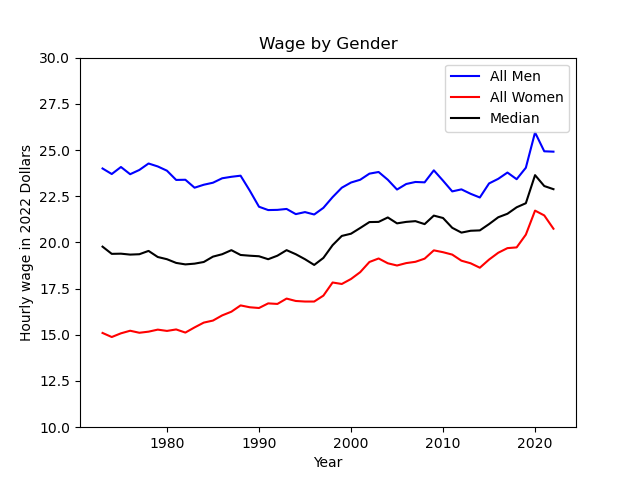 From the start of the reporting included in the data, men have consisantly earned more than woman. The greatest difference was in 1978, when the median wage per hour was $9.10 greater for a man than a woman. The closest median hourly wages for men and women were in 2011, where the difference was $3.42. Starting around 1990, the earnings followed similar trends of increases and decreases, but the gap has not closed.
From the start of the reporting included in the data, men have consisantly earned more than woman. The greatest difference was in 1978, when the median wage per hour was $9.10 greater for a man than a woman. The closest median hourly wages for men and women were in 2011, where the difference was $3.42. Starting around 1990, the earnings followed similar trends of increases and decreases, but the gap has not closed.
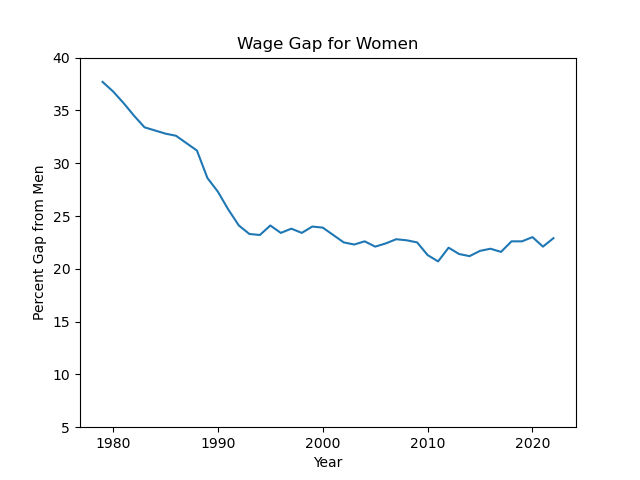 The wage gap as a percentage is described as “regression-based gender wage gap of 22.6 percent means that on average women are paid 22.6 percent less per hour than men, all else held equal (controlling for gender, race and ethnicity, education, age, and geographic location).” In theory, controlling for these differences should remove a gap. Men and women with the same qualifications in the same areas should be making roughly the same amount. But even controlling for these variables, women have constantly earned at least 20% less than men.
The wage gap as a percentage is described as “regression-based gender wage gap of 22.6 percent means that on average women are paid 22.6 percent less per hour than men, all else held equal (controlling for gender, race and ethnicity, education, age, and geographic location).” In theory, controlling for these differences should remove a gap. Men and women with the same qualifications in the same areas should be making roughly the same amount. But even controlling for these variables, women have constantly earned at least 20% less than men.
Racial Wage Gap
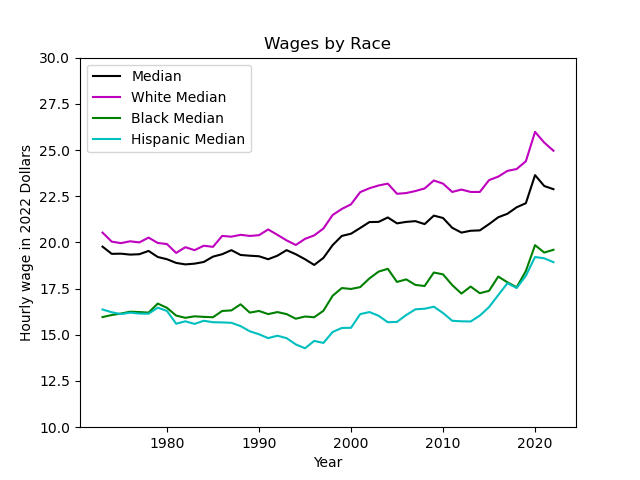 There has consistenly been a difference in the median hourly wage based on race. There are a few points during which Hispanic and Black earners earned the same as each other, but both groups have consistently earned less than White earners, with an average ofBlack workers earning $4.59 less and Hispanic workers earning $5.64 less per hour.
There has consistenly been a difference in the median hourly wage based on race. There are a few points during which Hispanic and Black earners earned the same as each other, but both groups have consistently earned less than White earners, with an average ofBlack workers earning $4.59 less and Hispanic workers earning $5.64 less per hour.
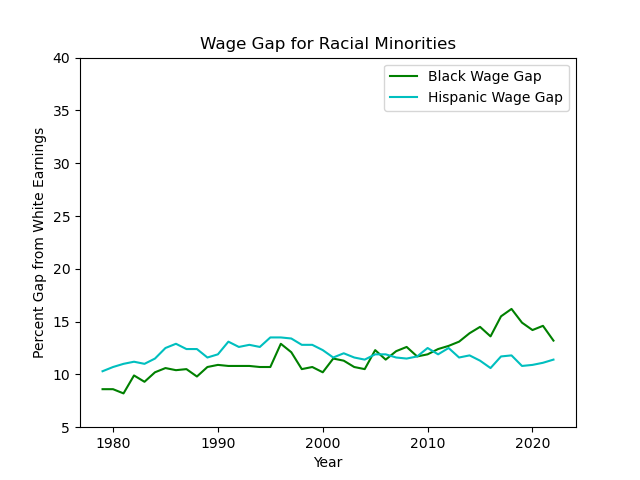
Controlling for gender, race and ethnicity, education, age, and geographic location, the gap for racial minorities is smaller than that of women, but still exists. Hispanic workers have consistently earned at least 10%, though no more than 13.5%, less than their White counterparts. Black workers have earned a range of 8.2% to 16.2% less than their White counterparts.
Race and Gender
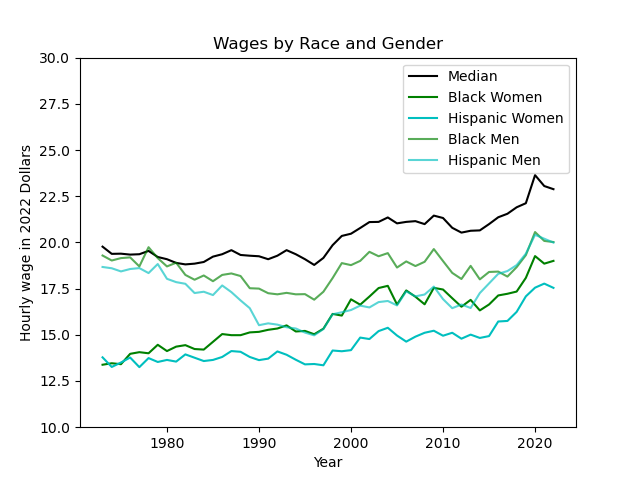 Excepting one year, Black and Hispanic workers of either gender have earned lower than the overall median. Women consistently earn less than the men of their racial group. Hispanic Women earn the least of any gender and race combination reported.
Excepting one year, Black and Hispanic workers of either gender have earned lower than the overall median. Women consistently earn less than the men of their racial group. Hispanic Women earn the least of any gender and race combination reported.
Conclusions
There is distincly a wage gap depending on the workers race and gender. Some may argue that it is because of the different jobs held by different races and genders. This then begs the question for further analysis, why are White Men in higher paying jobs than Hispanic Women?